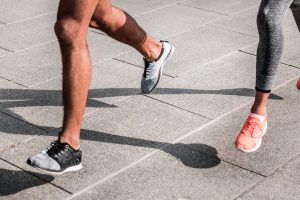You might have noticed that some runners are incredibly thin. This is especially true for marathon and long-distance runners.
This could lead you to wonder, “Why are runners so skinny?”
Runners are subjected to rigorous training and strict diets that help them burn fat and build lean muscle.
For example, a male elite marathon runner’s body fat percentage is likely to be between 5% and 11%, while female elite marathon runners’ body fat percentage is between 10% and 15%.
In this post, we take an in-depth look into what makes runners so skinny. We also explore if all elite runners are skinny and if you can run without becoming too skinny.

Why Are Runners So Skinny?
Generally speaking, running promotes fat loss. When you run for long, your body consumes its glycogen stock and then turns to fat for energy.
Runners almost never just run. They lead a healthy lifestyle, which includes eating smart and exercising often.
Runners Eat Smart
Portion Size
Running burns a lot of calories, but that doesn’t mean you don’t need to eat a proper, healthy diet. Runners who stay thin eat when they feel hungry and stop eating before they get too full.
Eating smart is about choosing satiating foods that can make you feel full longer.
Skinny runners probably burn more calories than they consume. That’s why they need to monitor their food intake and avoid overeating.
Lots of Fiber
An essential part of a healthy diet is eating lots of fiber. That’s why most runners incorporate high-fiber foods into their diets. Still, fiber isn’t just beneficial to your body; it can also promote weight loss.
High-fiber foods aren’t high in calories, yet our bodies take longer to digest them. That’s why we feel full for a long while after eating a high-fiber meal.
A study published in Annals of Internal Medicine suggests that increasing fiber intake in your diet doesn’t just promote weight loss. It also improves insulin resistance and decreases fasting plasma insulin.
Most skinny runners consume a lot of fiber through vegetables, fruits, and whole-grain foods.
Spreading Out Calories
Many runners, as well as athletes, spread out their calories throughout the day. They eat small, frequent meals and snacks instead of eating three large meals.
Some studies suggest that eating every three to four hours can stabilize your blood sugar and keep you from binging between meals or overeating during a meal.
What’s more, eating more frequently can help you maintain your energy levels.
Runners Exercise Often
Runners tend to be skinny because of their training habits. Most elite runners work out for more than two hours six days a week. This way of training prevents their bodies from storing any fat.
What’s more, most running training depends on more cardio and infrequent strength training. Runners, especially marathon runners, tend to focus on vigorous and long training. This type of training doesn’t bulk up muscles.
Runners Build Efficient Lean Muscles
Long-distance and marathon runners train to make their muscles more efficient. That said, even novice runners who follow a similar training pace can build efficient, lean muscles.
Muscles are made from slow and fast-twitch fibers. Slow-twitch muscles are lean and durable. They have a high fatigue resistance. Bulkier fast-twitch muscles, on the other hand, can generate more force but tire faster.
Your body relies on either depending on the activity. Endurance activities, such as long-distance and marathon running, mainly use slow-twitch muscles. That’s why runners are leaner but can endure running consistently for long distances.

Are All Runners Skinny?
There’s no rule that all runners have to be thin. Most runners are on the skinny side due to the nature of the exercise.
What’s more, most long-distance and marathon runners intentionally train and eat in order to reduce their body weight. They carry less load on the run by being lighter.
Other types of running necessitate big and strong muscles, so the runners are much bulkier.
Sprinting, for example, depends on bigger muscles to produce an immense amount of strength in a short period.
Can You Run Regularly Without Becoming Too Skinny?
It’s possible to run regularly without becoming too skinny. There are several tips that you can apply to your training and diet that ensure you maintain your desired weight and body composition.
Training
You should start by incorporating strength training as often as possible. If you only run or focus on aerobic training, you burn fat but your muscles don’t grow.
This isn’t necessarily a bad thing, but lean muscles make the body appear skinny. Strength training, also known as resistance training, helps grow and preserve muscle mass
Diet
According to the American Council on Exercise, running burns the most calories per minute out of all other activities and sports on the list.
For a 120-pound person, an hour of running burns over 600 calories. Runners burn way more in marathons. An elite runner, for example, burns about 1,854 calories in a marathon.
These numbers might not seem considerably high, but when you consider the number of hours spent training and the strict diets followed by most runners, they burn far more calories than they consume.
If you want to maintain your weight, you must consume as many calories as you burn.
That said, you should avoid consuming unhealthy foods while increasing your calorie intake.

Final Thoughts
So, why are runners so skinny? The truth is that runners don’t need to be so skinny. Running alone doesn’t make anyone skinny. Your weight and body composition depend on how you train and what you eat. You can be a runner who is bulky, skinny, or somewhere in between.
It’s a different story if you’re training to become an elite marathon runner. When you’re competing, you can’t afford to be bulky. Every extra pound is another pound you must carry during a marathon.
Interestingly, being so skinny is an advantage for long-distance and marathon runners. Their light and skinny bodies enable them to perform better. They run faster and longer without much difficulty.

